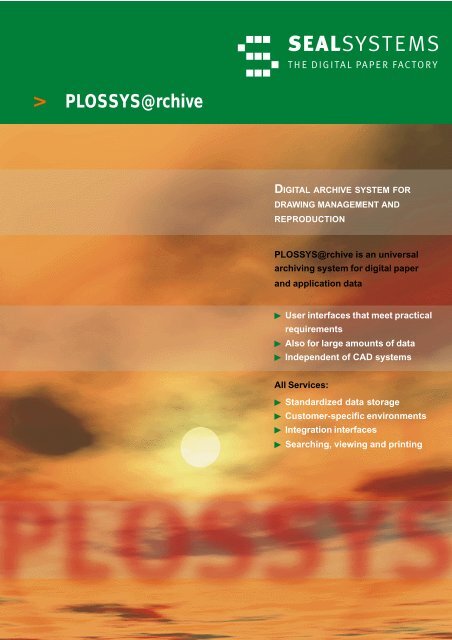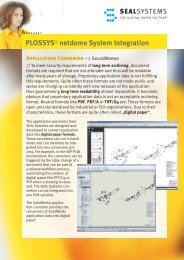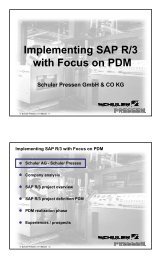You also want an ePaper? Increase the reach of your titles
YUMPU automatically turns print PDFs into web optimized ePapers that Google loves.
<strong>PLOSSYS@rchive</strong><br />
DIGITAL ARCHIVE SYSTEM FOR<br />
DRAWING MANAGEMENT AND<br />
REPRODUCTION<br />
<strong>PLOSSYS@rchive</strong> is an universal<br />
archiving system for digital paper<br />
and application data<br />
� User interfaces that meet practical<br />
requirements<br />
� Also for large amounts of data<br />
� Independent of CAD systems<br />
All Services:<br />
� Standardized data storage<br />
� Customer-specific environments<br />
� Integration interfaces<br />
� Searching, viewing and printing
<strong>PLOSSYS@rchive</strong><br />
The <strong>PLOSSYS@rchive</strong> is a universal archiving system for<br />
archiving and reproducing files of any type. It provides<br />
comprehensive query functions which allow a fast recherche.<br />
The <strong>PLOSSYS@rchive</strong> is an open system. It is neither<br />
dependent on a specific operating system nor on a specific<br />
CAD system.<br />
Apart from the linking with PLOSSYSTM netdome it offers<br />
further interfaces for integrating existing applications such as<br />
CAD systems, databases, viewers, editors as well as EDM/<br />
PDM systems.<br />
Fields of application<br />
The <strong>PLOSSYS@rchive</strong> can be used for many applications.<br />
Among the typical tasks there are:<br />
� Digital drawing archive for duplication:<br />
All drawings have been made available by means of scan<br />
processes and transfers from CAD systems and are<br />
present in digital form. By means of the <strong>PLOSSYS@rchive</strong><br />
these drawings can be managed in a convenient way. The<br />
tailored functions for creating duplication jobs can be used<br />
for many tasks with teller terminals or enterprise-wide, from<br />
the creation of repro jobs (ordering of drawings) up to<br />
visualization.<br />
� Digital archive as partial solution on the way to the<br />
introduction of an Engineering Database (EDM/PDM-<br />
System):<br />
The cost-efficient and quick introduction of<br />
<strong>PLOSSYS@rchive</strong> allows an immediate utilization of all the<br />
scan and print peripherals. Thus this system represents the<br />
ideal migration tool for introducing a design and product<br />
database.<br />
� Database for PLOSSYS ® netdome:<br />
The duplication and print services of the archive are<br />
extremely well-suited to the services of the universal print/<br />
repro system PLOSSYSTM . Thus all the PLOSSYSTM functions such as set processing with banner pages,<br />
stamping, drawing lettering, scaling and number of copies,<br />
high-performance printer operation with folding device<br />
control can be used in an optimal way.<br />
� Ideal for many industries and cases of application:<br />
Industrial enterprises with mass production, customized<br />
manufacture and order manufacture, large engineering<br />
offices and plant operators, machine building, automotive<br />
industry, plant construction and building industry, electrical<br />
and electronics industry.<br />
Archive objects<br />
The objects that are archived are application data, graphics<br />
and text files and describing master data. The files are stored<br />
by the <strong>PLOSSYS@rchive</strong> in the file system in a well-ordered<br />
way. The management information is kept in a separate table.<br />
The search and recherche processes access these tables.<br />
Basically any type of file can be put into the archives. These<br />
files may be CAD data models, vector and raster files or even<br />
text documents.<br />
� The System<br />
Database<br />
The <strong>PLOSSYS@rchive</strong> has its own database functionality that<br />
is required for an archiving system and that has been<br />
specifically optimized. Thus there will be no license fees for<br />
database systems.<br />
Alternatively existing ODBC-capable database systems can be<br />
used for managing the master data (e.g. Oracle, SQL Server).<br />
Safety<br />
The descriptive information in the archives is stored<br />
redundantly, so that the management information stored can be<br />
recovered, even if the archive is damaged.<br />
The basic system includes services for recovery as well as for<br />
re-organization and data stock maintenance.<br />
Archiving functions<br />
� Creating, editing and deleting master data<br />
� Archiving and adding a document<br />
� Exporting the document and the master record (local<br />
storage)<br />
User and authorization management<br />
The management process is oriented to the Windows NT<br />
operating processes. The following items can be set:<br />
� User and user group authorizations<br />
� Login and password processes<br />
� Documents and functions authorizations<br />
� Views and field conditions<br />
These functions also allow a safe external access to the<br />
archives, for example via the Internet.<br />
Search functions<br />
� Wildcard (*) search<br />
� Relational search (Compare, NOT, AND, OR, ...)<br />
� Minimum and maximum criteria<br />
� Search dialogs and found matches can be stored
� Searching, Viewing<br />
Data modeling<br />
The data model on which the archive is based can be defined<br />
freely, for example<br />
� attribute name, � attribute type,<br />
� attribute length, � creating keys,<br />
� defining mandatory and optional fields.<br />
Thus the information which is individually required for each<br />
application can be stored in the archive.<br />
For any defined attributes a key for the direct and quick<br />
access can be determined.<br />
Visualization<br />
For displaying archive data all commercially available display<br />
programs can be integrated. The <strong>PLOSSYS@rchive</strong> is not<br />
bound to a specific product. In many cases the following<br />
programs are used:<br />
� Spicer Imagenation � Acrobat Reader<br />
� NT Tiff-Viewer � Application programs: Word,<br />
Excel, AutoCAD, ...<br />
Mini image<br />
The PLOSSYS TM preview functionality allows a fast selection<br />
of documents on a graphic basis. The user can select very<br />
conveniently from a survey sheet with stamp-sized images.<br />
Printing and duplicating<br />
Convenient print/repro functions for the output allow a purposeand<br />
receiver oriented output of long and short lists of<br />
documents.<br />
The print function parameters that can be set include:<br />
� printer (output device) � number of copies<br />
� marginal lettering � folding type<br />
� stamp texts � scaling factor or target format<br />
� cost center � output medium<br />
� number of sets � banner page texts<br />
� file printing<br />
The <strong>PLOSSYS@rchive</strong> allows to create and manage receiver<br />
profiles. Receivers are addressees of print/repro jobs. Each<br />
receiver can be assigned an adjustable set of print/repro<br />
parameters, especially an output device.<br />
� Creating, deleting, maintaining receivers<br />
There are receivers that are centrally managed and personal<br />
receivers.<br />
� Reproducing<br />
Repro list<br />
The work area of the archive is referred to as repro list. The<br />
repro list may contain both document information (master<br />
records) and duplication information (print parameters). The<br />
repro list can process incompletely classified entries. It is also<br />
possible to enter document data of documents that have not<br />
been stored in the archive yet. The <strong>PLOSSYS@rchive</strong> can<br />
handle them properly (creating omission sheets, creating scan<br />
job, ...).<br />
� Entering the repro list<br />
Document data can be input via a separate input line.<br />
These data need not describe the document completely.<br />
Afterwards one can check by means of the function<br />
“Expand”, whether there are archive entries related to these<br />
document data.<br />
� Editing the repro list<br />
� Selecting, cutting, copying entries<br />
� UNDO function � Assigning a distributor<br />
� Assigning receivers � Assigning print parameters<br />
� Expanding<br />
Checking for all entries or only the selected entries of the<br />
repro list, whether there are archive entries, and displaying<br />
these in the repro list.<br />
� Opening, saving, printing, deleting, adding a repro list<br />
By means of these functions, for example, project- and jobrelated<br />
lists can be created and used for other processes,<br />
without having to search again in each case. The repro list has<br />
a simple documented ASCII format.<br />
These lists can also be created by third-party systems (for<br />
example PPS/ERP), and are then processed by PLOSSYSTM automatically. In this way very effective processes for making<br />
available drawings can be implemented.<br />
Control functions<br />
A number of settings control the behavior of the system:<br />
� Output generally as set or single sheets<br />
� Activating min/max criteria<br />
Using a set criteria (e.g. displaying only the latest version<br />
of a document)<br />
� Determining processing processes, if drawings and/or data<br />
are not available in the archive<br />
The <strong>PLOSSYS@rchive</strong> can process repro jobs in which also<br />
documents or master records that have not been stored in the<br />
archive yet are specified and for which there is no object. The<br />
user can decide how the system is to proceed in such a case:<br />
1. Printing/distributing the repro list; omission sheets are<br />
inserted for objects not available.<br />
2. A scan job is created. This job can be processed quickly<br />
and safely by means of the PLOSSYSTM Scan List Client.<br />
After the scan job has been completed, the repro list is<br />
output/processed.<br />
3. The available documents are output immediately; for the<br />
missing documents a scan job is created. After the scan<br />
job has been completed, the rest of the documents is<br />
output.
� Extensions<br />
Demand-oriented scanning<br />
(„Scan-on-demand“)<br />
By means of the specific dialog processes of the<br />
<strong>PLOSSYS@rchive</strong> documents can be ordered the master<br />
record of which has not been stored in the archive yet. It is<br />
also possible to request documents that have not been<br />
scanned yet.<br />
The PLOSSYSTM repro list processing allows together with the<br />
Scan List Client to build up very effective acquisition<br />
processes.<br />
Also with partly filled archives a safe and user-friendly<br />
operation is possible.<br />
Workflow<br />
This extension allows the implementation of defined operating<br />
sequences:<br />
� release � updating service<br />
� quality assurance � four-eyes process<br />
Distribution services<br />
Distributors are lists of receivers and related print/repro<br />
parameters.<br />
Archive distributor: the distribution information is assigned to<br />
an object in the archive (changeable).<br />
Standard distributor: centrally stored and maintained<br />
distributors which are assigned to the object with printing.<br />
Personal distributors: locally stored and maintained<br />
distributors which are assigned to the object with printing.<br />
Temporary distributors: momentarily created distributor<br />
which is assigned to the object with printing.<br />
The following distribution functions are available:<br />
� Creating, deleting, maintaining, displaying a distributor<br />
The print/repro parameters that can be set include:<br />
� distributor name � marginal lettering<br />
� printer � folding type<br />
� number of copies � stamp texts<br />
� number of sets � receiver name<br />
� banner page text<br />
� Interfaces<br />
Repro Archive Universal Client (RAUC)<br />
The fully graphic user interface is the standard user surface.<br />
The mask operation and control with mouse and keyboard<br />
allows fast and faultless working. A comprehensive help<br />
functionality supports the user. The user prompt meets the<br />
practical requirements and is available in several languages.<br />
The end user can configure his program surface in such a way<br />
that it meets the requirements of his tasks:<br />
� Layout of the main display and the list of found matches<br />
� Defining the layout of the drawing list (banner page) and the<br />
master data dialog<br />
� Defining plot ID names (for job tracking)<br />
� Help function<br />
� Display of version<br />
� Starting other applications<br />
With the design great importance has been attached to a<br />
simple, intuitive user prompt. The layout meets modern<br />
Microsoft and Motif standards. Actions that cannot be<br />
activated are masked out or represented in shaded form. All<br />
important operational actions can be activated both by means<br />
of the menu operation and via colored buttons (icons).<br />
Scan List Client<br />
The special application for the scan workstation: request lists<br />
can be processed in a semi-automatic way. The basic<br />
functions include:<br />
� Selecting, displaying and printing the scan list<br />
� Scan result: displaying and editing<br />
� Assigning request and scan result<br />
� Displaying, adding and archiving master data<br />
By means of demand-oriented scanning the archive becomes<br />
useful very fast.<br />
WWW interface<br />
The Internet interface for the <strong>PLOSSYS@rchive</strong>. HTML, JAVA,<br />
SSL and HTTP are the standards for our implementation.<br />
Ideal for large and spread sites with heterogeneous<br />
infrastructure and for linking external archive users such as<br />
field service, customers and suppliers.<br />
ARCLI command line interface<br />
The script interface “arcli” (archive command line interface)<br />
allows to formulate important archive functions also on shell<br />
level. For example, simple batch-oriented archiving and export<br />
processes can be defined in process environments.
� Input-/output interfaces<br />
Load process<br />
Standard modules for loading the <strong>PLOSSYS@rchive</strong> fast:<br />
� Loading master data from the PPS/ERP or a drawing<br />
management<br />
� Loading object data from the scanner, CAD or PDM<br />
� During starting (initial program loading) and operation<br />
� With the integration of additional steps: rastering, rotation,<br />
...<br />
Repro list processing<br />
RLIST is the PLOSSYS TM standard format for repro lists. The<br />
repro list processor allows the automated processing of<br />
complete repro jobs in batch operation. The repro list is<br />
generated in another system and is transferred to<br />
PLOSSYS TM . The documents are accessed through the<br />
<strong>PLOSSYS@rchive</strong>. For the task-related making available of<br />
documents manual intervention is no longer required.<br />
Raster export<br />
Compiling and exporting of comprehensive document lists for<br />
CD production, creation of subarchives and archives for old<br />
versions as well as for data backup. The structuring of the<br />
objects and the data can be set-up according to the<br />
requirements of the tasks.<br />
Modular design and practice-oriented licensing<br />
PLOSSYS can be extended with function groups. Thus<br />
investments have to be made only for functionality that is<br />
needed. Nevertheless all PLOSSYSTM services can be added<br />
later.<br />
PLOSSYSTM has no licensing which restricts the number of<br />
users.<br />
Modern system architecture and standards<br />
Client/server architecture for TCP/IP networks for a simple<br />
system design.<br />
PLOSSYSTM is multiclient capable. All interfaces and user<br />
surfaces can be operated simultaneously.<br />
C++, JAVA and Perl are our new development standards.<br />
System environment<br />
<strong>PLOSSYS@rchive</strong> is available for all client server<br />
environments.<br />
Server<br />
� IBM AIX<br />
IRIX<br />
� HP-UX � Silicon Graphics<br />
� Digital Unix � Windows NT � Sun Solaris 2<br />
Clients<br />
� IBM AIX � Silicon Graphics IRIX<br />
� Digital Unix � SunOS<br />
� HP-UX � Sun Solaris 2<br />
� openVMS � Windows 3.11/95/98<br />
� Windows NT � Netscape Communicator<br />
� Internet Explorer<br />
PLOSSYS TM netdome<br />
The standard print/repro system with all services for digital<br />
document printing:<br />
� Output on all printers including final processing<br />
� Stamping, water marks, marginal lettering, set processing<br />
� Output operation and printer management<br />
� For CAD, digital Archive, PDM and PPS<br />
Format converter<br />
We have proven standard converters for conversions from and<br />
into TIFF/G4, HPGL/2, C907, PostScript, PDF, CGM and<br />
many other formats.<br />
SAP R/3 DVS<br />
For the standard application SAP R/3 there is a special<br />
version of the <strong>PLOSSYS@rchive</strong>:<br />
The proven user surfaces are offered as add-ons for the SAP<br />
standard module DVS and a standard filing system such as<br />
SAP electronic vault or ArchiveLink. For these applications the<br />
following PLOSSYSTM products are available:<br />
DVS Repro, DVS Distribution Printing, DVS Repro Scan List Client.
<strong>PLOSSYS@rchive</strong><br />
� Filing documents in digital form, searching<br />
and reproducing them („digital paper“)<br />
� Fast recherche through practice-oriented<br />
dialogs<br />
� Display of drawings and documents on<br />
the screen<br />
� Ordering and distribution processes from<br />
the workstation or in teller terminal service<br />
� Comprehensive user and authorization<br />
management<br />
� Distribution control: plotting jobs from<br />
PPS/PDM systems as sorted sets<br />
� Efficient design of the digital archive<br />
through demand-oriented scanning<br />
<strong>SEAL</strong> <strong>Systems</strong> solves your problems<br />
You tell us your requirements, and we will coordinate<br />
the procurement of the devices and the<br />
software, and will take care of installation, system<br />
integration and commissioning.<br />
In this way requirements become practice-oriented<br />
solutions.<br />
� reliable project management<br />
� experienced installation and integration teams<br />
� expertly performed acceptance tests<br />
� configuration consulting<br />
� hotline service<br />
<strong>SEAL</strong> <strong>Systems</strong> AG & Co. KG<br />
Lohmühlweg 4 • D-91341 Röttenbach<br />
Phone: +49 (0) 9195/926–0 • Fax: +49 (0) 9195/1739<br />
http://www.sealsystems.com • E-Mail: info@sealsystems.de<br />
© 2002 <strong>SEAL</strong> <strong>Systems</strong> AG & Co. KG. PLOSSYS is a registered trademark of<br />
<strong>SEAL</strong> <strong>Systems</strong>. Other computer and software names mentioned in this<br />
brochure are trade names and/or trademarks of the respective manufacturers.<br />
Subject to change without notice. As of date of: August 14, 2002.




